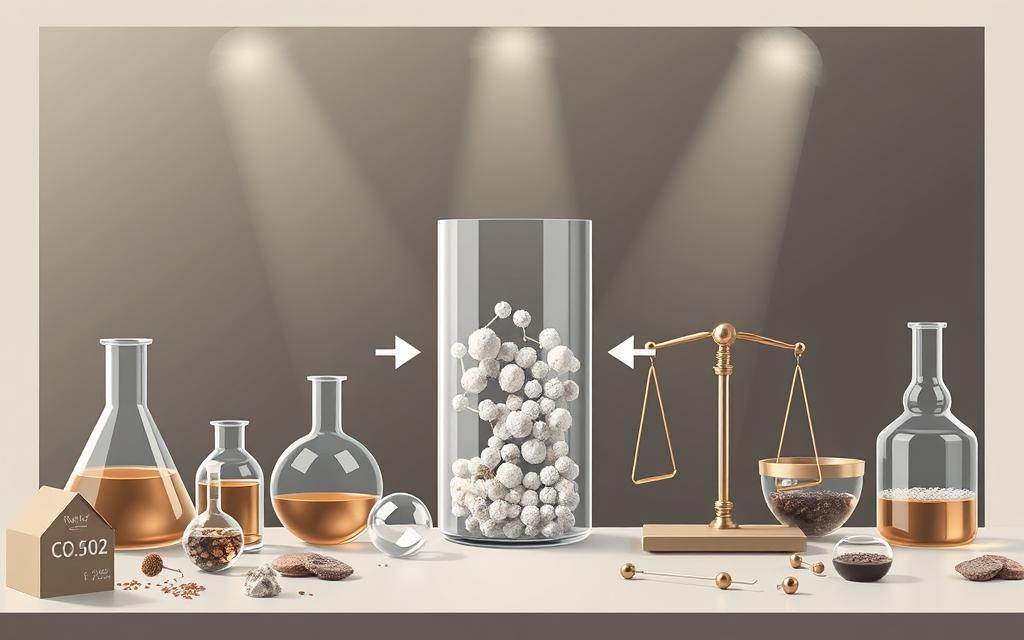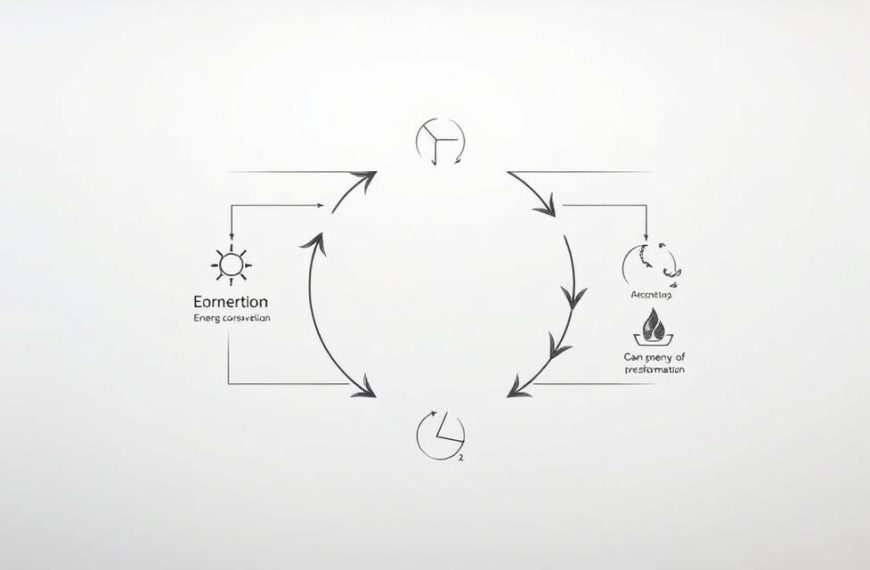Every physical or chemical process in our universe follows a fundamental rule: the total quantity of matter remains unchanged. This principle governs everything from campfires to cellular respiration, forming the bedrock of modern chemistry and physics.
Scientists discovered centuries ago that substances merely reorganise during reactions rather than vanish. When wood burns, its atoms combine with oxygen to form gases and ash. Though appearances alter, no particles magically disappear – they simply rearrange into new configurations.
This concept proves indispensable for professionals across scientific disciplines. Educators use it to explain balanced equations, while engineers apply it to optimise industrial processes. Even environmental researchers rely on these principles when tracking pollutants through ecosystems.
Modern physics introduces fascinating exceptions through Einstein’s mass-energy equivalence. However, classical scenarios – from baking bread to rusting metal – still adhere strictly to the original theory. Understanding these boundaries helps learners grasp both historical scientific thinking and contemporary advancements.
Our exploration will demonstrate how this enduring principle underpins chemical analysis, material science, and even space exploration. Practical examples reveal why recognising matter’s persistence remains crucial for solving real-world challenges.
Introduction to the Conservation of Mass
The journey to uncover matter’s unchanging nature spans millennia. Early civilisations proposed revolutionary ideas about material persistence, setting the stage for modern scientific understanding.
Historical Background and Early Discoveries
Jain scholars in 520 BCE declared universal constituents cannot be destroyed or created. Greek philosophers later echoed this, with Empedocles arguing against spontaneous generation of substances. These concepts remained philosophical until the 18th century.
Mikhail Lomonosov’s 1756 experiments shattered phlogiston theory, proving combustion doesn’t eliminate matter. His work prioritised measurable evidence over mystical explanations. Antoine Lavoisier built upon this, demonstrating through precise measurements that closed systems retain identical mass before and after reactions.
Fundamental Principles and Definitions
The core tenet states: matter reorganises but never disappears. In practical terms, atoms merely rearrange during physical or chemical changes. Rusting iron exemplifies this – oxygen combines with metal, increasing weight while keeping total mass constant.
This principle applies universally across states and forms. Whether water evaporates or plastics degrade, atoms persist in different configurations. Modern science recognises exceptions in nuclear reactions, but classical scenarios strictly adhere to mass preservation.
Chemical Reactions and Mass Conservation
From rust formation to roaring flames, substances reorganise themselves without atomic loss. This fundamental truth becomes clearest when examining molecular transformations. Chemical processes showcase nature’s meticulous bookkeeping – every atom finds new partnerships while maintaining original quantities.
Illustrative Examples from Combustion Reactions
Consider calcium reacting with oxygen: 2Ca + O₂ → 2CaO. Two metal atoms combine with one oxygen molecule, creating two calcium oxide units. Atomic counts remain identical – no particles vanish, merely regroup.
Methane combustion reveals similar patterns: CH₄ + 2O₂ → CO₂ + 2H₂O. Four hydrogen atoms from methane pair with oxygen to form water, while carbon joins oxygen atoms creating carbon dioxide. The exact number of each element persists throughout this energetic transformation.
Understanding Reactants and Products
Stoichiometry – the mathematics of reactions – relies entirely on balanced atomic counts. If 100g of reactants enter a process, 100g of products emerge. Industrial chemists exploit this principle to predict yields and minimise waste.
This balance explains why forest fires don’t destroy matter. Burning wood converts cellulose into gases and ash, redistributing atoms rather than eliminating them. Modern laboratories still apply these 18th-century insights when analysing complex biochemical processes.
Physical Changes and the Unchanging Mass of Matter
Shifting between solid, liquid, and gas states reveals matter’s persistent nature. Physical transformations alter appearances but preserve atomic quantities – a principle critical for understanding material behaviour.
Phase Transitions in Water and Other Substances
Consider H2O’s journey from ice to vapour. A 1g ice cube becomes 1g liquid, then 1g steam. Though molecular arrangements shift, hydrogen and oxygen atoms remain constant. Each molecule retains two hydrogen atoms bonded to one oxygen atom throughout.
| State | Mass (g) | Hydrogen Atoms | Oxygen Atoms |
|---|---|---|---|
| Ice | 1 | 2.22×1023 | 1.11×1023 |
| Water | 1 | 2.22×1023 | 1.11×1023 |
| Steam | 1 | 2.22×1023 | 1.11×1023 |
Energy changes drive these transitions. Melting ice absorbs heat without altering atomic counts. Similarly, compressed gases or expanding metals maintain fixed mass despite structural changes.
Industrial processes exploit this stability. Pharmaceutical distillation relies on precise mass calculations during evaporation. Environmental scientists track pollutants through phase changes, knowing substances persist despite form shifts.
Exploring what is the law of conservation of mass
From stars to soil, atomic persistence shapes our world’s dynamics. This principle extends beyond laboratories, influencing cosmic phenomena and ecological networks alike.
Mass-Energy Equivalence and Modern Exceptions
Einstein’s E=mc² revolutionised scientific thinking by revealing matter’s convertible nature. Nuclear reactions demonstrate this vividly – uranium atoms lose mass during fission, releasing immense energy. 1g of converted mass produces 90 trillion joules, powering cities through atomic reactors.
| Process | Mass Change | Energy Released |
|---|---|---|
| Nuclear Fusion | 0.7% loss | 6.3×10¹⁴ J/kg |
| Coal Combustion | 0% | 2.4×10⁷ J/kg |
| Battery Discharge | 0% | 1.8×10⁵ J/kg |
Classical scenarios still obey original principles. Burning fossil fuels rearranges carbon atoms without mass loss – CO₂ molecules simply enter atmospheric cycles.
Application in Biogeochemical Cycles and Environmental Systems
Nature’s recycling systems showcase atomic preservation. A single carbon atom might spend centuries cycling between air, trees, and ocean currents. Photosynthesis captures CO₂, converting it into glucose while releasing oxygen.
Environmental scientists track pollutants using these principles. Mercury from industrial waste persists through ecosystems, accumulating in fish without disappearing. Conservation laws enable precise modelling of climate change impacts across geological timescales.
Urban planners apply these concepts when designing waste management systems. Every tonne of recycled plastic maintains material integrity, reducing landfill growth through strategic atomic redistribution.
Conclusion
Atomic bookkeeping governs every interaction in our observable world. The mass preservation principle remains indispensable for explaining phenomena from rust formation to star fusion. Scientists and engineers rely on its predictability when balancing equations or designing sustainable technologies.
Einstein’s E=mc² equation expanded our understanding without negating classical concepts. Nuclear reactions demonstrate energy-mass conversion, while everyday processes still obey original conservation rules. This duality enables precise calculations in fields ranging from pharmacology to climate science.
Mastering these principles empowers professionals to model ecosystems and optimise industrial systems. Students gain critical tools for analysing material transformations, whether tracking carbon cycles or recycling plastics. The persistence of atoms underpins both laboratory experiments and planetary-scale processes.
From Bronze Age metallurgy to modern quantum physics, matter’s unwavering consistency shapes human progress. Recognising this fundamental truth allows us to innovate responsibly, ensuring solutions align with nature’s unbreakable arithmetic.

















